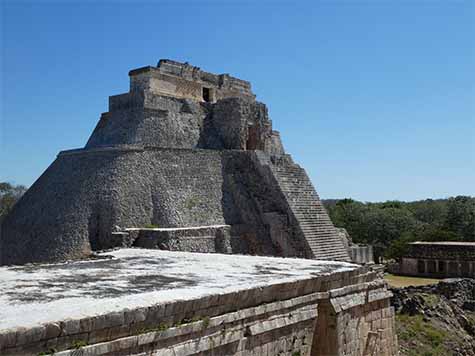Ruins of Ancient Mayan City of Uxmal | Yucatan Mexico

One of Yucatan’s gems has its incredible history within its name, which means "built three times."
Classified on the World Heritage List by Unesco in 1996, Uxmal is an ancient city from the classical period of the Mayan civilization. Located in Mexico, about 80 kilometers from the ocean, in a region of hills of the Yucatan, it is characterized by a very particular architectural style, Puuc, made of tiles decorated with sacred figures that cover the rough stone, and of rich ornaments of refined craftsmanship, carved in relief on the stone.
The word uxmal would mean, in the Mayan language, "three times built". The site was inhabited in ancient times, but the present city was not founded until the 7th century AD, by the Xiuh family, until it was occupied by the Toltecs in the 10th century. As in all of Yucatan, water resources were scarce, and it is for this reason that Chac, the God of Rain, was the most revered deity of all. Completely abandoned in 1200 - perhaps because of Chac's wickedness - the city was quickly devoured by the jungle. And it was not until seven centuries passed before Uxmal saw the light again in the 19th century.
The site stretches 1,000 meters from north to south and 500 meters from east to west, and conceals eight groups of sacred buildings symbolizing power: Pyramid of the Magician, the Nunnery Quadrangle, the palace of the Governor (with a wonderful throne in the shape of a two-headed jaguar), the House of the Turtles, the large ball court, the house of the Doves and the temples. In front of the Governor's Palace is a shattered monolith, a kind of cylinder with a conical end that is the subject of much discussion: some see it as a tribute to fertility and others claim that it is a mysterious object fallen from the sky, which would have sunk into the ground.
The Pyramid of the Magician

Dominating the site from a height of 35 meters, the Pyramid of the Magician (also known as the Pyramid of the Dwarf) is undoubtedly the most imposing and the most attractive building. What makes it so unique are its rounded edges (a feature only found here) and elliptical base. On its summit rises a temple entirely decorated with eerie masks that are said to represent the jaws of the mighty god Chac. Local legend has it that the edifice was built in one night by a dwarf, with the help of his mother's magical practices. It was probably the temple of an oracular deity who manifested himself through a priest-prophet. The virtual line that unites the pyramid with the center of the Nuns' Quadrangle marks the point on the horizon where the sun sets, the day it passes through the zenith.
According to Stansbury Hagar - an ethnographer who lived in the first half of the 20th century - the skulls and bones that adorn the facade indicate that the temple is dedicated to the god of death. He thinks the wide access road to the west facade is shaped like an open mouth: the jaws of a human face. It would be a symbolic representation of death through which one must pass in order to come into contact with the diviner making his oracle. The pyramid would also represent the constellation of Scorpio which is connected with the god of Death. Stranbury Hagar researched the Uxmal site extensively and published an article in 1921 on the correspondence between the zodiac and the temples of Uxmal. He hypothesized that all the sacred cities of the Mayans had been designed to reproduce a celestial model. The Mayans indeed believed that the microcosm corresponded to the macrocosm and that everything on Earth was an imitation or reflection of the perfect reality existing in the Universe. By imitating the celestial vault, the sacred city would have collected part of this perfection. Hagar, who studied the position and characteristics of the individual architectural elements found on the map of Uxmal, managed to distinguish in each of them one of the twelve constellations of the zodiac, based on the correspondences he had identified (with the exception of Aquarius for which there was nothing left but a small temple in ruins). On the other hand, it is certain that the Mayans were astonishing connoisseurs of sky and time, as shown in their complicated and very precise calendars, and in their disposition to predict eclipses. How they were able to increase their knowledge and what is true about their prophecies, it remains to be discovered.









































































































































































































































































































































